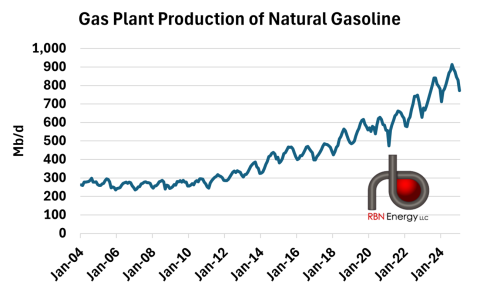It’s the most expensive NGL, accounting for more than 25% of the value of a weighted average barrel. It is the only NGL that does not require storage or transportation under pressure. And it’s the most misunderstood of the NGLs, going by different names depending on the market and geography, with a chameleon-like characteristic that allows it to be transformed into various products. And to further complicate matters, other petroleum liquids are similar to natural gasoline, but not identical. In today’s RBN blog, we’ll delve into the mysteries of natural gasoline and explore what makes it such a crucial component of the hydrocarbon landscape.
Like all the NGLs, U.S. natural gasoline production has increased dramatically since the onset of the Shale Revolution. As shown in Figure 1 below, before shale, natural gasoline production from gas processing plants (the only source of “real” natural gasoline) was less than 300 Mb/d. Over the past decade, volumes have tripled, now approaching 900 Mb/d. As production volumes ramped up, new markets for the product emerged, a topic we’ll revisit in a moment. But first, what is natural gasoline in the first place? What makes it natural? And is it really gasoline?
Figure 1: Gas Plant Production of Natural Gasoline. Source: EIA
The name — natural gasoline — comes from its source and its qualities. It is “natural” because it comes from natural gas, not a refinery. And it is “gasoline” because the product is similar to very low-quality motor gasoline. It has an API gravity of around 80 degrees, making it very light with low density. (For more on API gravity, see Don’t Let Your Crude Oils Grow Up To Be Condensates). Natural gasoline is the heaviest product in the mixed NGL stream produced at a natural gas processing plant and is the heaviest cut from an NGL fractionator. Chemically, it is composed mostly of pentanes, a compound with five carbon atoms (C5). The stream also includes smaller amounts of heavier molecules including hexanes, heptanes and higher (C6, C7, C8). The molecules are nearly all paraffinic, meaning they have as many hydrogen molecules as possible (also known as saturated hydrocarbons).
Join Backstage Pass to Read Full Article









